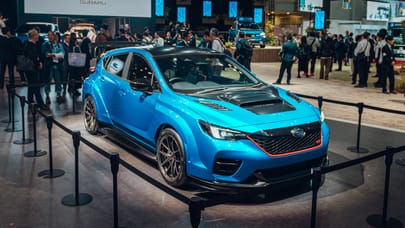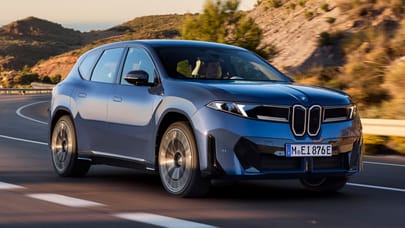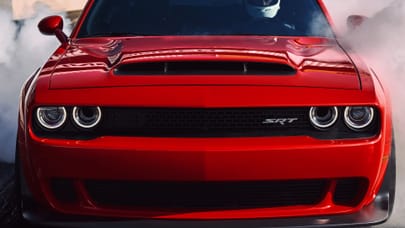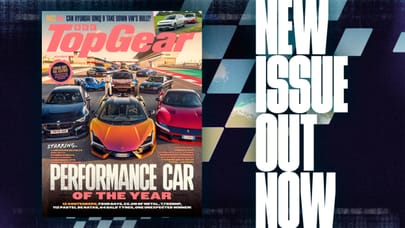

Depending on the car and road, anything above 150mph is generally where things turn a bit Twilight Zone.
Above 150, you get personally introduced to the concept of airflow, aerodynamics and, most of all, downforce. You can feel the front wheels squirm a bit, things might suddenly go a bit light and, if the boffins haven't done their sums correctly, your bottom will be the first part of your anatomy to alert you to the fact. For this reason, you'd be right to feel a little apprehensive.
None of these things happen in the Bugatti Veyron 16.4 Grand Sport Vitesse. (It's a mouthful and the Vitesse bit makes me think of soggy old Rover, so let's go with GSV for short.) Good job, too, because this is a roadster that will do 255mph.
Words: Jason Barlow
Photos: WolfangoThis feature was originally published in the May 2012 issue of Top Gear magazine
Advertisement - Page continues below
This means that 150mph in the GSV equates to about 50mph in a normal car. Getting your personal, in-built speedometer to calibrate itself according to this fact is a bit like watching the needle on the speedo of a knackered old Triumph Stag flailing helplessly about. Your eyes, and indeed bottom, are firing responses along your neural information super highway to your brain, but the Bugatti simply outpaces them. It's the strangest feeling, as if everything you know is wrong.
Right now, the data-logging blue box affixed to the lower part of the windscreen is reading 319kph, although I'm only spying its numerals out of the corner of my eye for obvious reasons. That's 198mph. And the truth is that, while 198mph is really quite fast, the Veyron is such a remarkable piece of engineering that we have landed this far into the Zone without breaking sweat.

Well, metaphorical sweat. Your actual perspiration is inescapable, because we are deep in the South African veldt; it's summertime in this part of the world, and the mercury is nudging 38 degrees. Strap yourself into a Veyron - which is basically a portable power station - in these sticky conditions, and you learn all you need to know about ‘heat soak'. Even if the roof is off and you're being ventilated at high speed.
But then that's the whole point of this mission. The GSV is effectively the Veyron Super Sport with a detachable roof panel, so more than ever this is a car that's designed to be usable on a daily basis, right across the spectrum of its awesome abilities. This is obviously no mean feat in a vehicle that features 1,187bhp - yes, you read that right - and 1,100lb ft of torque. It absolutely shouldn't work, and it certainly shouldn't do its thing without throwing the odd Elton John-style hissy fit. But it does.
Advertisement - Page continues below
This southernmost tip of Africa puts us on the same line of longitude as Sydney, and there's unrelenting heat and dust as well as stunning scenery and verdant hills. A deputation of Bugatti engineers has come here to make sure that the car doesn't lunch itself when faced with sustained high-temperature, high-speed running. Top Gear has joined them for a few days, in an attempt to find out what they actually have to do to make a car with no roof work at 255mph. Imagine.
Bugatti's key guys have spent so long in the engineering equivalent of the Twilight Zone, it's a wonder they can still walk straight. Jens Schulenburg and Christian Weiss are the poor souls entrusted with keeping us in line for the next 48 hours, along with Bugatti's lugubrious and quite brilliant PR man and ‘head of tradition' Julius Kruta. (Julius probably won't mind me revealing his full name: Franz Julius Liberius Sinbad Kruta - "My parents were rather bohemian," he says with a rueful grin.)

You don't want to be stuck in the arse end of nowhere, however picturesque, with people you wouldn't want to have a beer with, and luckily our compact crew enjoys a little light refreshment and a laugh. Jens, in particular, is quite a character. He's a Veyron veteran, having been on the programme from day one (work started back in 2001, which seems hard to believe). He reckons he's racked up in excess of 50,000km over the years in various Veyrons, and once did 10 zero-225mph-zero runs to see if it was possible in a distance of 2,300m ("I needed another 300m," he says). Well, it beats winter testing in a Polo.

In the early phases of the car's development, which, if you remember, were beset with the sorts of problems you'd imagine would affect a 1,000+bhp, W16 road car, Jens worked on its electrical network, and had to figure out a way to package the associated componentry. This makes him something of a genius. But he also owns a Morris Traveller and a Morgan Plus 8, so beneath the steely German engineering exterior, he's evidently a bit nuts too. We like that. That said, a brief overview confirms that this testing malarkey is no place for anyone afflicted with attention-deficit issues or inconvenient idiosyncrasies. This is a gigantically process-driven business, and only works if all concerned can stay focused in often very demanding conditions, know how to plug a computer in properly, and can count.

Given that the Veyron was and remains VW group overlord Dr Ferdinand Piëch's pet project, the whole enterprise still ticks over with a frontier spirit and lustrous sheen (though not the car itself, as we'll soon discover. It's the hardest-working Bugatti in the world). I even find out the German for ‘empirical' - ‘empirische'. Given that the only German phrase I can usually remember is ‘Mein Spiegelei ist nicht hier' (‘my fried egg isn't here'), this promises to be a highly educational few days.
The next morning we decamp to VW's enormous test facility, on the outskirts of the seaside town of Port Elizabeth. The town itself is a slightly bewildering mix of relatively well-heeled neighbourhoods and poorer areas, even more cheek by jowl than you'd find in some British towns and cities. There's big surf out here, the beach is stunning, and there's a parade of posh condos and hotels fringing it.
Advertisement - Page continues below
VW's Port Elizabeth facility sits in the middle of the town's industrial hinterland. The company manufactures Polos here, and the Citi - a lightly reheated version of the MkI Golf - continues in production, too. There's loads of them about, which gives the place a slightly time-warp feel.
There's a decent enough test track here, too, but only VW's Ehra-Lessien track - on which James May shed his Captain Slow alter ego once and for all in the Super Sport two years ago - is big enough to handle the Veyron. So we'll be briefed here, before setting off into the countryside on an unofficially official test route.

Overseeing us is a bear of a man called Jacques. It immediately becomes clear that Jacques is not a man to be messed with, and, given that this is an official VW group test session, we are required to observe the rules, the health and safety ones in particular, to the letter. While Top Gear is the acme of professionalism at all times, we're also used to winging it when necessary, and it seems that Jacques can smell dissent.
"You do what I say," he says in his clipped Afrikaans accent, though he hails from Belgium, "and you do it when I say. This is a very powerful car, and at this time of year wild horses think nothing of straying onto the road. You don't want to hit one of them at 120mph, believe me. And watch out for the monkeys, too. They're not as friendly as they look."
Advertisement - Page continues below
The Veyron GSV is equally foreboding. Though I've driven several Veyrons, and attended the original 2006 launch in Sicily, I've only ever seen one in the wild, and time hasn't diluted its ability to shock. It isn't pretty, but it's pretty amazing, a solid hunk of carbon whose body flows in an almost seamless, slightly porcine arc. As with most mega cars, your eye is drawn to the tyres, which are so huge they're like orbiting moons. They're hand-made, cost 20 grand a set and the pressures can reach 3.6 bar at high speed. In fact, they would explode if the car wasn't limited to 255mph.
In becoming a GSV, various alterations have taken place. Visuals, first. There's a new roof spoiler, disguised with white tape on this prototype, that splits the airflow over the car into two separate streams to reduce noise. There are larger air intakes at the front, primarily to cool the front differential. Look closely, and you'll spot additional, slimmer intakes beneath the front lights, which help dissipate heat around the wheelhouse area.

The GSV is approximately 200bhp more powerful than the regular Grand Sport, thanks to the fitment of larger turbochargers (four of them) and new intercoolers. There are new fuel pumps (four of those, too), borrowed from the SS, to handle the GSV's even more manic combustion requirements. The drivetrain's components have been beefed up, the DSG's innards reinforced, and the brakes and brake cooling improved. There are new dampers, to quell pitch and dive under acceleration, and the ESP stability management system has been adjusted to intervene a little later than before. Apparently, the Veyron can generate lateral acceleration of 1.4g, which is just another in its armoury of amazing statistical facts.
I'm not sure I have the stomach for 1.4g. It's not on the cards today, whatever, because we're here to do high-speed, straight-line stuff. This, I can handle, even if Jacques' moustache is twitching. VW's test facility has an arrangement with the South African government that permits them to run at speeds up to - a flexible - 124mph, so, thrillingly, we get a sticker that reads ‘high speed test vehicle approved by government' on the Veyron. Black on yellow, it even looks like a British registration plate.
Jacques is at pains to point out that this does not constitute a ‘get-out-of-jail-free' card.

Our convoy heads off. While Jens drives, I ask him what the work really entails. This is the glamour end of the car business, but even here it's repetitive stuff. Vital, but repetitive. "We come to this part of the world to run tests on the car's temperature management - on the transmission, front and rear differential, engine, brakes. It's a very dusty environment, so we measure how much dust gets drawn into the air filters. Then we can work out how long they'll function before they need to be replaced. We'll run repeated acceleration tests, drive the car fast, then suddenly switch the engine off. Will the pumps be able to cope with it?"
A day in the wild is usually followed by an evening back at base, number-crunching. If the test HQ is too far to drive back to, they'll camp out, though they have to be mindful of snakes and scorpions. In the Northern Cape Territory, Jens remembers, one of his colleagues found himself face-to-face with a yellow cobra, and another disturbed a nest of snake eggs in one of the workshops.

"We drive and we capture data," he continues. "Then that night we download the data and sift through it. I write a report and send it to my boss back in Wolfsburg. The team at home will assess my findings and might decide that we need to develop a part, or find something we can optimise."
For an engineer of this calibre, it's a dream project. But it's also a rather odd existence.
"The whole process can take weeks," Jens admits. "So I know my colleagues better than I know my own wife."

No other car on earth sounds like a Veyron. If its speed and acceleration is all about bullying the air into doing what it wants, its 8.0-litre engine is a masterpiece of forced induction. Even at normal speeds, it's an ever-present monster of a thing, hissing and whistling and belching, cylinders and pistons pumping furiously about 12 inches from the back of your head. It's an unconventional soundtrack, sure, but the quicker you go, the better it gets, and what it lacks in harmony it makes up in sheer sonic drama.

The Veyron stops traffic and gathers little huddles of spellbound onlookers on the gilded streets of Mayfair. As we pass through the town of Steytlerville, about 100 miles away from Port Elizabeth, it arrives into the locals' lives with a similar impact to the spaceship's climactic descent in Close Encounters. But it's a bittersweet moment. We've seen the grinding poverty of the townships on the outskirts of Port Elizabeth on our way here, and the sheer size and preponderance of graveyards is a testament to South Africa's desperate Aids crisis. Driving a near-£2m car in this context is to question the morality of all such things.
Steytlerville is a poor town, but the Veyron is besieged and becomes the star of a multitude of mobile-shot images and films. Jacques frets that some of them will end up on YouTube or Facebook. I'm just pleased to witness such a joyful response.

The road leading out of the town is the one we'll be using. We drive about 10 miles before pulling into a lay-by. Minutes later, we set off in the Veyron, building speed gradually in preparation for a full-bore acceleration run. The engine farts and roars under a brutal, midday sun. Monkeys scamper about at the roadside. The Veyron's tyres rumble. "This road," I say to Jens, "is it straight like this for, what, 10km?"
He smiles, as the wind eddies over the top of the screen. "Oh no. It's like this for another 60km..."
With that, we bury the throttle, the Veyron hits warp factor nine and commits GBH on the laws of physics. Again.







